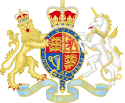William Wood, 1. Baron Hatherley
William Page Wood, 1. Baron Hatherley PC (* 29. November 1801 in London; † 10. Juli 1881 ebenda) war ein britischer Staatsmann und Rechtsgelehrter.
Leben
William Wood, geboren als zweiter Sohn von Matthew Wood, dem langjährigen Vertreter der City of London im Parlament, wurde am Winchester College erzogen, studierte am Trinity College in Cambridge, wurde 1827 am Lincoln’s Inn zur Anwaltschaft zugelassen und war von 1847 bis 1852 für den Wahlkreis Oxford Mitglied des House of Commons, in welchem er sich der Liberal Party anschloss.
Von 1849 bis 1851 war er Vize-Chancellor of the Duchy of Lancaster. Er wurde 1851 zum Ritter geschlagen,[1] war von 1851 bis 1852 als Nachfolger von Alexander Cockburn Solicitor General und bekleidete daraufhin das Amt des Vizekanzlers des High Court of Justice, der faktisch der Präsident der Chancery Division dieses Gerichts ist.
1868 trat Wood als Lordkanzler in das Ministerium Gladstone ein und wurde, da er als solcher dem House of Lords vorzusitzen hatte, als Baron Hatherley, of Down Hatherley in the County of Gloucester,[2] zum Peer erhoben.[3]
Im Oktober 1872 legte er sein Amt wegen Augenschwäche nieder und starb am 10. Juli 1881. Sein Titel erlosch mit seinem Tode, da seine Ehe kinderlos blieb.
Politisch liberal, gehörte Hatherley zur kirchlich-orthodoxen Partei, wie seine Schrift beweist: Continuity of Scripture as declared by the testimony of our Lord (4. Aufl. 1870).
Literatur
- William Richard Wood Stephens (Hrsg.): A memoir of the Right Hon. William Page Wood baron Hatherley. Richard Bentley & Son, London 1883, 2 Bände.
- Hatherley, William Page Wood, 1st Baron. In: Encyclopædia Britannica. 11. Auflage. Band 13: Harmony – Hurstmonceaux. London 1910, S. 62–63 (englisch, Volltext [Wikisource]).
Einzelnachweise
- ↑ Nr. 21201, S. 1045. The London Gazette. 18. April 1851.
- ↑ Nr. 23449, S. 6591. The London Gazette. 11. Dezember 1868.
- ↑ Powicke, Fryde: Handbook of British Chronology. Second Edition, London, 1961, S. 88.
| Personendaten | |
|---|---|
| NAME | Wood, William, 1. Baron Hatherley |
| ALTERNATIVNAMEN | Hatherley, William Page Wood 1. Baron; Sir William Page Wood |
| KURZBESCHREIBUNG | britischer Politiker, Mitglied des House of Commons und Rechtsgelehrter |
| GEBURTSDATUM | 29. November 1801 |
| GEBURTSORT | London |
| STERBEDATUM | 10. Juli 1881 |
| STERBEORT | London |
Auf dieser Seite verwendete Medien
Autor/Urheber: Sodacan, Lizenz: CC BY-SA 3.0
Royal Coat of Arms of the United Kingdom of Great Britain and Northern Ireland in the style used by the Government of Queen Elizabeth II from 1952 to 2022 (as used in all places except Scotland).
| “ | Quarterly, First and Fourth Gules three lions passant guardant in pale Or armed and langued Azure (for England), Second quarter Or a lion rampant within a double tressure flory counter-flory Gules (for Scotland), Third quarter Azure a harp Or stringed Argent (for Ireland), the whole surrounded by the Garter; for a Crest, the imperial crown Proper; for Supporters, dexter a lion rampant guardant Or crowned as the Crest, sinister a unicorn Argent armed, crined and unguled Proper, gorged with a coronet Or composed of crosses patée and fleurs de lys a chain affixed thereto passing between the forelegs and reflexed over the back also Or; Motto 'Dieu et mon Droit’ ('God and my Right') below the shield. | ” |
- PINCHES, J.H & R.V., The Royal Heraldry of England, 1974, Heraldry Today.



